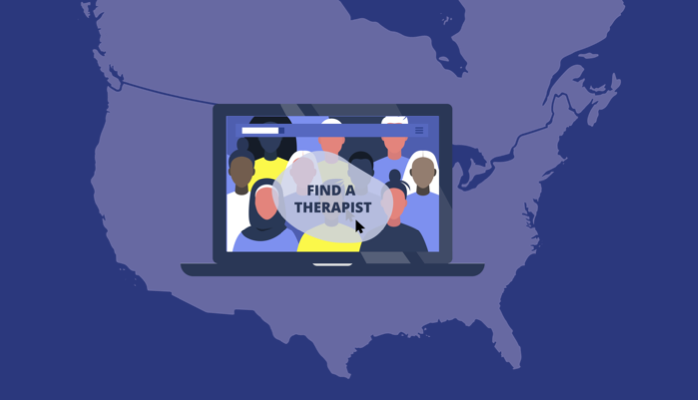- Learn about different types of mental health care professionals.
- Download our "Important Questions for Your Therapist and Insurance Carrier" infographic.
- The Wisdom of Cognitve Behavioral Therapy (CBT): The Perfect Gift for New Moms - blog post
- So You've Decided to Start Therapy for Your Anxiety: Here's How to Make it Work - blog post
Anxiety disorders and depression are treatable. Many people experience meaningful symptom relief and improvement in their quality of life with professional care. However, treatment success varies. Some people respond to treatment after a few weeks or months while others may take longer. If people have more than one anxiety disorder or if they suffer from other co-existing conditions, treatment may take longer. An experienced provider will conduct a comprehensive assessment before discussing an individualized treatment plan. Download our Therapy Options Guide infographic.
Types of Therapy
- Cognitive-Behavioral Therapy (CBT)
- Exposure Therapy
- Acceptance and Commitment Therapy (ACT)
- Dialectical Behavioral Therapy (DBT)
- Interpersonal Therapy (IPT)
- Eye Movement Desensitization and Reprocessing (EMDR)
Cognitive-Behavioral Therapy (CBT)
A well-established, highly effective, and lasting treatment is called cognitive-behavioral therapy, or CBT. It focuses on identifying, understanding, and changing thinking and behavior patterns. Benefits are usually seen in 12 to 16 weeks, depending on the individual.
In this type of therapy the patient is actively involved in his or her own recovery, has a sense of control, and learns skills that are useful throughout life. CBT typically involves reading about the problem, keeping records between appointments, and completing homework assignments in which the treatment procedures are practiced. Patients learn skills during therapy sessions, but they must practice repeatedly to see improvement.
- Watch ADAA's Video on CBT.
- Download our What is CBT? infographic.
Check out four helpful evidence- based videos produced by the Washington University Pediatric & Adolescent Ambulatory Research Consortium, Washington University Medical School. The videos feature ADAA member Melanie Van Dyke, PhD. The videos cover: Evidence-based Therapy for Adolescent Depression, Cognitive Behavioral Therapy, Selecting a CBT Therapist and How to Know if Therapy is Working.
Read this ADAA blog post: Three Things I Need to Know About CBT (Cognitive-Behavioral Therapy)
Exposure Therapy
A form of CBT, exposure therapy is a process for reducing fear and anxiety responses. In therapy, a person is gradually exposed to a feared situation or object, learning to become less sensitive over time. This type of therapy has been found to be particularly effective for obsessive-compulsive disorder and phobias.
Virtual Reality Exposure Therapy (VRE)*
VRE is a type of exposure therapy that uses virtual reality (i.e., interactive computer-generated simulations) to present the patient with stimuli for exposure therapy with a therapist. Exposure therapy helps people confront what they fear in a therapeutic manner so that the fear decreases. VRE has the advantage of being able to present situations that may be difficult to arrange in real life, for example, flying on an airplane for someone with the fear of flying. The therapist can exactly control the VRE stimuli to create the perfect exposure for that patient, for example, making sure there is no turbulence until the patient is ready for turbulence. Research supports VRE for PTSD, social anxiety, and specific phobias (e.g., fear of heights and flying).
The virtual reality system is just a tool used within VRE – it is not the therapy. Patients interested in VRE should not be directed toward equipment but rather clinicians trained in VRE and explore how VRE might provide additional benefits over conventional exposure therapy.
#VRE content authored by Barbara O. Rothbaum, PhD, ABPP and Andrew Sherill, PhD
Watch ADAA's video on Exposure Therapy.
Acceptance and Commitment Therapy (ACT)
Also known as ACT, this type of therapy uses strategies of acceptance and mindfulness (living in the moment and experiencing things without judgment), along with commitment and behavior change, as a way to cope with unwanted thoughts, feelings, and sensations. ACT imparts skills to accept these experiences, place them in a different context, develop greater clarity about personal values, and commit to needed behavior change.
Watch ADAA's video on Acceptance and Commitment Therapy.
Dialectical Behavioral Therapy (DBT)
Integrating cognitive-behavioral techniques with concepts from Eastern meditation, dialectical behavioral therapy, or DBT, combines acceptance and change. DBT involves individual and group therapy to learn mindfulness, as well as skills for interpersonal effectiveness, tolerating distress, and regulating emotions.
Watch ADAA's video on Dialectical Behavioral Therapy
Interpersonal Therapy (IPT)
Often referred to as IPT, interpersonal therapy is a short-term supportive psychotherapy that addresses interpersonal issues in depression in adults, adolescents, and older adults. IPT usually involves 12 to 16 one-hour weekly sessions. The initial sessions are devoted to gathering information about the nature of a person’s depression and interpersonal experience.
Eye Movement Desensitization and Reprocessing (EMDR)
EMDR is a type of therapy that can help you heal from past life events that impact you in the present. Utilizing bilateral stimulation, through eye movements, tapping, and/or tones, EMDR taps into a natural healing process in our brain that helps to “unlock” distressing memories. In doing so, it reduces the overall emotional and physical distress connected to a memory and shifts a negative belief to an adaptive belief. Research supports the effectiveness of EMDR as a therapy to target past traumatic and distressing experiences.
- Check out this article: Considering EMDR Therapy? What to Expect.
- Read more about EMDR from the National Center for PTSD
Find a Therapist Near You
Search our ADAA directory of licensed mental health providers who specialize in anxiety disorders, depression, OCD, PTSD, and related disorders. Many ADAA members also offer telemental health services.
Listen to our webinars on CBT:
- Can CBT Help with Neurological Disorders?
- Overcoming Social Anxiety: Cognitive Behavior Therapy (CBT) to Build Self-Confidence and Lessen Self-Consciousness
- Cognitive Behavioral Therapy (CBT) for Tinnitus Distress
- Helping Kids and Teens Who Have OCD
- Taking the Terror Out of Terrorism: How CBT Can Relieve Your Anxiety
- What Is Cognitive-Behavioral Therapy and How Is It Used to Treat Anxiety and Depression?
Trending Articles
- How to Find a Therapist featuring ADAA board president, Beth Salcedo, MD and ADAA member Lynn Bufka, PhD
- How to Tell if You Should See a Psychiatrist Versus a Psychologist featuring ADAA member Michelle G. Newman, PhD
- 15 Things to Look for in a Therapist













